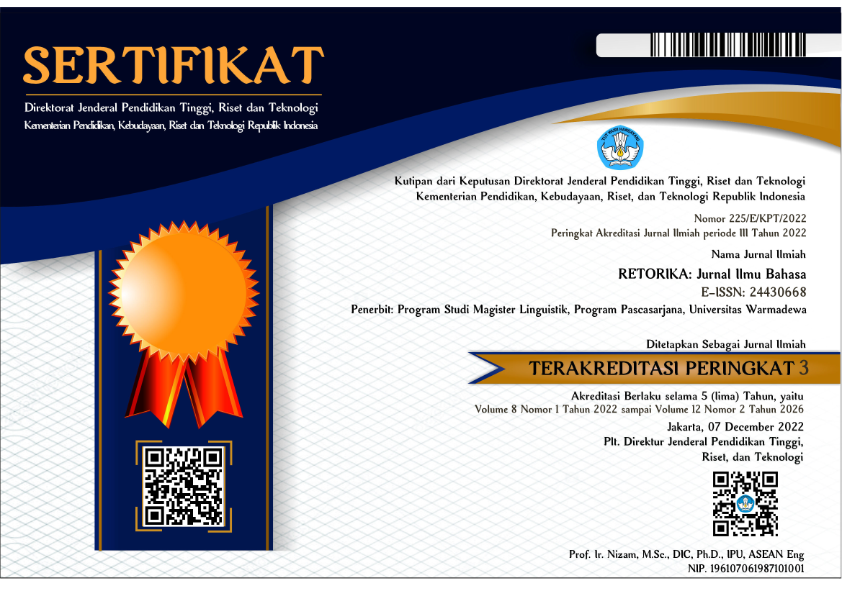Conversation in Advertising at Public Radio of Denpasar City
Abstract
This study aims to analyze the structure and the type of speech acts, as well as the maxims of conversation in ten adverstisement spots, aired by LPPL Public Radio of Denpasar City. Data were collected through observation, recording and note-taking. I analyzed the data qualitatively with an inductive technique. Results indicated that there were three conversation structure models srealized in the conversation broadcast on the Public Service Advertisement by LPPL Public Radio. Negative speech acts were found in nine of the advertisement spots. Quality and quantity maxims were found in nine advertisement spots too; maxim of relevance and manner were found in ten advertisement spots. The models of turn talking, adjacency pair and overall organization using positive speech acts and maxims of quality, quantity, relation and manner were required for the conversation in the advertisement. Maxim of manner plays a crucial important role in the delivery of messages. There are significant correlations of the topic with the maxims realized. These comprise turn talking model requiring positive speech acts in the maxim of quality and maxim of relevance and the adjacency pair model requiring positive speech acts that always correlate with the maxim of quantity. The overall organization model calls for positive speech acts in the conversations with maxim of manner. The negative speech acts in the conversation can use the turn talking, adjacency pair or overall organization model and can correlate with the maxim of manners.References
Allan, K. (1986). ROUTLEDGE LIBRARY EDITIONS: LINGUISTICS Volume 8 LINGUISTIC MEANING. New York: Routledge.
Arrington, R. L. (2012). Advertising. Encyclopedia of Applied Ethics, 47–55.
Atifi, H., Mandelcwajg, S., & Marcoccia, M. (2011). The co-operative principle and computer-mediated communication: The maxim of quantity in newsgroup discussions. Language Sciences, 33(2), 330–340.
Bayat, N. (2013). A Study on the use of Speech Acts. Procedia - Social and Behavioral Sciences, 70, 213–221.
Brumark, Å. (2006). Non-observance of Gricean maxims in family dinner table conversation. Journal of Pragmatics, 38(8), 1206–1238.
Degand, L. (2006). Speech Acts and Grammar. Encyclopedia of Language & Linguistics (Second Edition), (1982), 673–679. -7
Ehsani, F., & Zohrabi, K. (2014). Assessing Translation of Advertising Text ( English-Persian ) Based on House ’ s Functional -Pragmatic Model of TQA. Procedia - Social and Behavioral Sciences, 98, 420–424.
Ephratt, M. (2012). “We try harder†- Silence and Grice’s cooperative principle, maxims and implicatures. Language and Communication, 32(1), 62–79.
Koester, A. J. (2002). The performance of speech acts in workplace conversations and the teaching of communicative functions. System, 30(2), 167–184.
Lazăr, A. (2013). Teaching Absurd Literature–A Pragmatic Approach to Ionesco’s Transgressive Dramatic Discourse: The Conversational Maxims. Procedia - Social and Behavioral Sciences, 76, 441–445.
Lewis, S. W. (2012). The potential for international and transnational public service advertising in public spaces in American and Chinese global cities: Conclusions from a 2010 survey of advertisements in subways in Beijing, New York, Shanghai and Washington, DC. Public Relations Review, 38(5), 765–778.
Miller, S. (2000). Speech acts and conventions. Language Sciences, 22(2), 155–166.
Pe, M., & Martı, G. (2012). A pragmatics theory on television advertising, 44, 453–473.
Schrøder, K. C. (2006). Media : Pragmatics. Elsevier, (1980), 623–631.
Simon, S., & Dejica-Cartis, D. (2015). Speech Acts in Written Advertisements: Identification, Classification and Analysis. Procedia - Social and Behavioral Sciences, 192, 234–239.
Simpson, P. (2001). “ Reason †and “ tickle †as pragmatic constructs in the discourse of advertising *, 33, 4–7.
Stone, M. P., & Miceli, T. J. (2012). Optimal attorney advertising. International Review of Law and Economics, 32(3), 329–338.
Stranovská, E., Munková, D., Fráterová, Z., & ÄŽuraÄková, B. (2013). Analysis of Politeness Speech Acts in Slovak and Foreign Language Texts of Requests in the Context of Cognitive Style. Procedia - Social and Behavioral Sciences, 82, 764–769.
Tajabadi, A., Dowlatabadi, H., & Mehri, E. (2014). Grice’s Cooperative Maxims in Oral Arguments: The Case of Dispute Settlement Councils in Iran. Procedia - Social and Behavioral Sciences, 98(1975), 1859–1865.
Vergis, N. (2017). The interaction of the Maxim of Quality and face concerns: An experimental approach using the vignette technique. Journal of Pragmatics, 118, 38–50.
Copyright (c) 2018 RETORIKA: Jurnal Ilmu Bahasa

This work is licensed under a Creative Commons Attribution-ShareAlike 4.0 International License.
This journal provides immediate open access to its content on the principle that making research freely available to the public supports a greater global exchange of knowledge.
All articles published Open Access will be immediately and permanently free for everyone to read and download. We are continuously working with our author communities to select the best choice of license options, currently being defined for this journal as follows: Creative Commons-Non Ceomercial-Attribution-ShareAlike (CC BY-NC-SA)
 Abstract viewed = 233 times
Abstract viewed = 233 times
 PDF downloaded = 226 times
PDF downloaded = 226 times

2.png)














